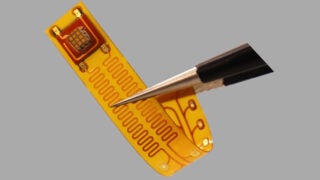A better way to detect breast cancer?
Biomedical engineer’s new system for tissue imaging could save millions of lives
In the mix of attention-grabbing headlines about cancer, you’ll see many about treatments, risks and possible causes, but how many cover innovations in the detection of cancer? Not many, which is odd since early detection is one of the most significant factors in cancer survival rates.
This fact is not lost on Vasilis Marmarelis, professor of biomedical engineering at the USC Viterbi School of Engineering. His new system for detecting breast cancer could save, without exaggeration, millions of lives.
With the current protocol, a woman who finds a lump in her breast is sent for a mammogram to confirm the presence of the lump. Since mammograms can’t distinguish between a benign cyst and a malignant tumor, she then may get a handheld ultrasound to further image the lesion. The next step is a biopsy — the surgical removal of tissue for further testing in the lab — to diagnose or rule out breast cancer.
Superior technology
Mastoscopia, the system devised by Marmarelis, uses a technology called multimodal ultrasound tomography (MUT) to image the breast in search for cancerous lesions. The technology is far superior to the current imaging techniques used in four distinct ways: It’s sensitive, specific, safe and comfortable.
Sensitive: The smallest tumor an X-ray mammogram can distinguish is about 10 millimeters in diameter. A MUT scan can detect lesions as small as 2-3 mm, a significant difference. “The prognosis improves exponentially the smaller you find it,” Marmarelis said. “We can save a lot of lives.”
Specific: MUT, unlike X-rays, can correctly differentiate between benign lesions in general and a malignant tumor with just one scan. There is no need for further screening and surgeries to diagnose breast cancer.
Safe: The X-rays that mammograms currently use are called ionizing radiation. X-rays carry so much energy that as they pass through the body, they can scramble DNA and damage the body’s cells. For this reason, repeated mammograms could actually cause cancer. Ultrasound waves don’t have this effect. It doesn’t impart the body with harmful radiation.
Comfortable: Mammograms require the breast tissue to be flattened for scanning. With MUT, you can scan the whole breast without any tissue manipulation. The Mastoscopia system consists of a bed where a patient lies down and allows the breast to rest naturally inside a water-filled imaging tunnel. It’s through this tunnel that a series of ultrasound waves pass and render a 3-D image of the breast.
“Since MUT does not use radiation and therefore can be repeated frequently at no harm or discomfort for the patient, women with genetic predisposition for breast cancer — having the genes BRCA1 and BRCA2 — can benefit immensely by using MUT to frequently check and track suspicious lesions from a young age,” Marmarelis said.
Another benefit: lower costs
Mastoscopia is also less expensive and easier for physicians to use.
A typical mammogram system costs anywhere from $400,000 to $600,000. Mastoscopia will cost around $300,000.
When physicians read results from mammograms or handheld ultrasounds, there is a certain amount of user error. Two different doctors could interpret the data in two different ways. Mastoscopia takes the guesswork out of the analysis. After the scan, the system developed by Marmarelis processes and assembles a series of horizontal scans of the breast into one composite image. Each point in the image is given a numerical value. A lesion with a point value above 1.0 is dangerous. Healthy breast tissue on this scale is around 0.3.
Initially developed at USC under sponsorship by the Alfred E. Mann Institute, Marmarelis has since taken Mastoscopia to his native Greece. Since 2009, clinical tests with more than 300 women at Hippokration University Hospital of Athens have produced encouraging results.
In December 2013, the second Mastoscopia device went to University Hospital Basel in Switzerland for additional clinical trials.
The next progression of this promising technology will be clinical trials in the United States. With government approval, Marmarelis can fulfill a longtime dream of helping as many people as possible. When one in eight women will be diagnosed with invasive breast cancer in her lifetime, Marmarelis’ technology can ensure that it is found as early as possible.
“In addition to this being a matter of considerable passion for me, it is also a matter of tremendous importance for all women, and by extension, all people on this planet.”



